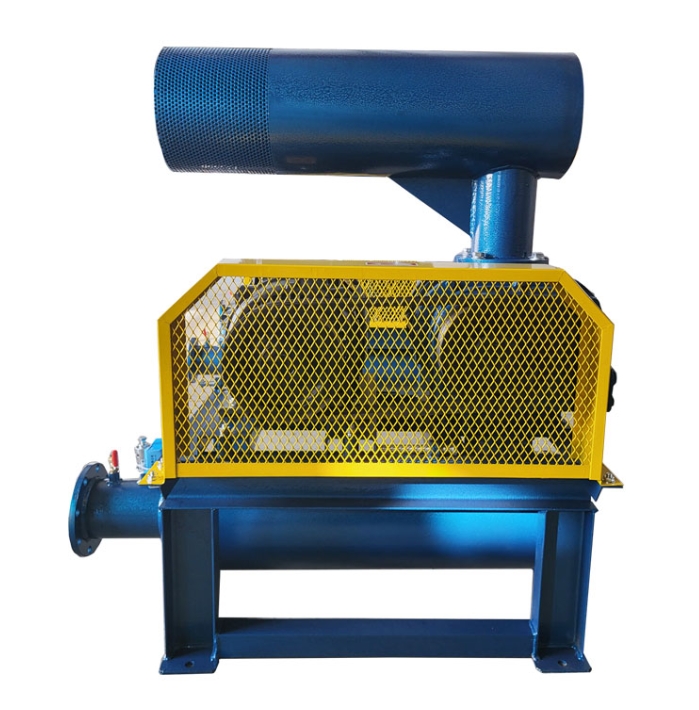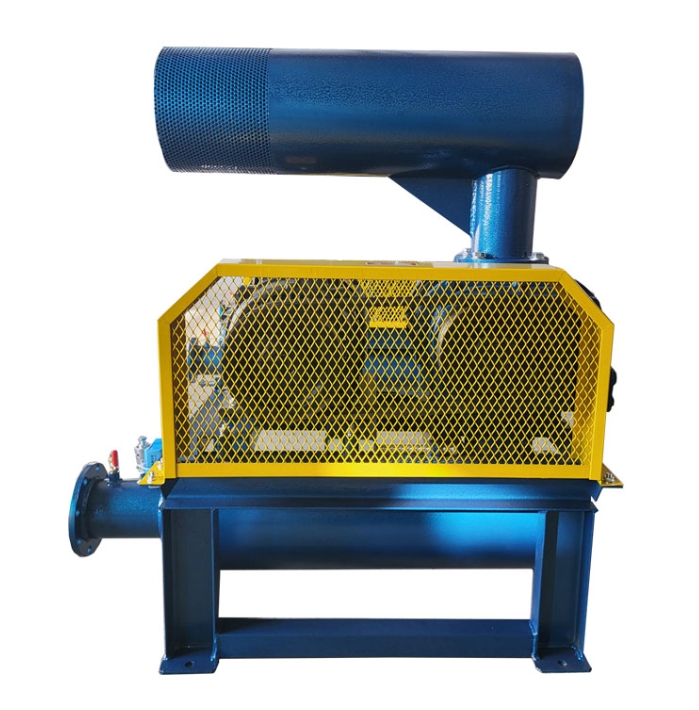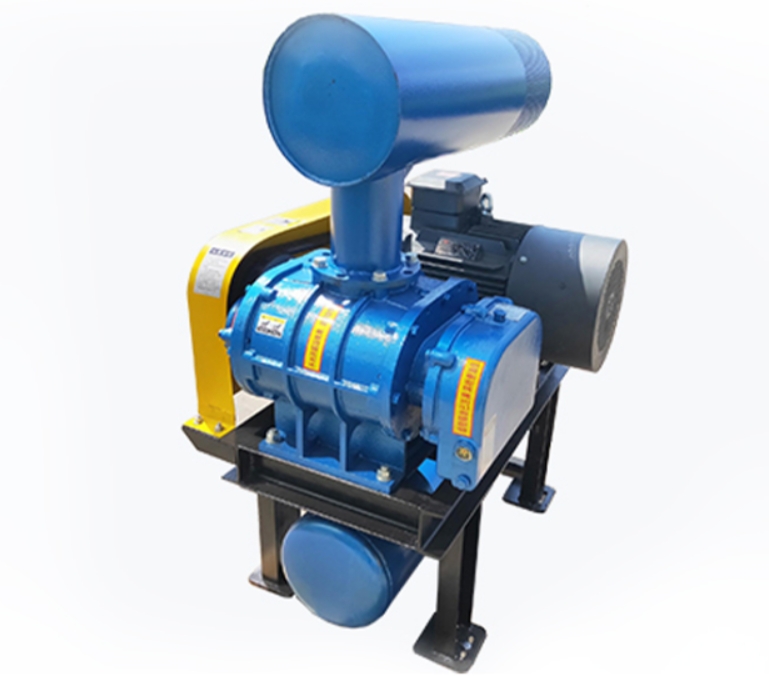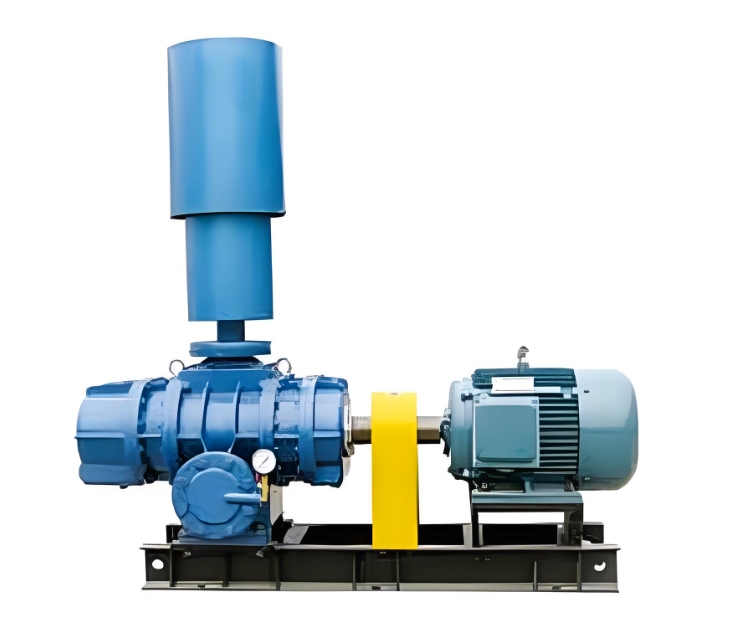**Selection Method for Roots Fan Aquaculture (Professional Edition)**
In aquaculture (such as fish ponds, shrimp ponds, and circulating water systems), the selection of Roots blowers directly affects the oxygenation effect, energy consumption, and aquaculture efficiency. The following is a scientific selection method, covering key parameters such as air volume, pressure, power, and aeration system matching.
---

**1、 Selection of core parameters**
**1. Airflow (Q) - determines oxygenation capacity**
**Calculation formula * *:
\[
Q \, (\text {m}3 /\Text {h}=\ text {volume of water body} \, (\text {m}3 )\ times \ text {ventilation rate} \, (\ text {times/hour})
\]
-* * Water volume * *=fish pond area (㎡) × average water depth (m)
-Ventilation rate reference (adjusted according to breeding density):
|Type of aquaculture * * | Ventilation rate (times/hour) | Applicable scenarios|
|------------------|------------------|-----------------------|
|* * Ordinary fish pond * * | 0.5~1.0 | Low density (grass carp, crucian carp)|
|* * High density shrimp farming * * | 1.5~2.0 | Shrimp and swamp shrimp (yield per mu>500kg)|
|* * Industrialized circulating water * * | 2.0~3.0 | Sea bass, grouper (RAS system)|
**Example calculation * *:
-* * 10 acre fish pond (2 meters deep) * * → Water volume=10 × 666.7 × 2 ≈ * * 13334 m3**
-* * High density shrimp farming (ventilation rate 1.5) * * → required air volume=13334 × 1.5 ≈ * * 20000 m3/h**
---
**2. Pressure (P) - depends on water depth and pipeline losses**
**Calculation formula * *:
\[
P \, (\ text {bar})=0.1 \ times \ text {water depth} \, (\ text {m})+\ text {pipeline loss} \, (Usually 0.05~0.1 bar)
\]
-For every 1 meter increase in water depth, the pressure needs to increase by 0.1 bar**
-Aeration tube resistance: nanotubes (0.02~0.05 bar), ordinary aeration disc (0.05~0.1 bar)
**Example calculation * *:
-Water depth of 2 meters+nanotubes (0.03 bar) * * → required pressure=0.1 × 2+0.03 ≈ * * 0.23 bar**
---
**3. Power (kW) - determined by air volume and pressure**
**Empirical formula * * (Roots blower efficiency ≈ 60~70):
\[
\Text {power} \, (\text{kW}) ≈ \frac{Q \, (\text {m}3 /\Text {min} \ times P \, (\ text {bar})} {60 \ times \ text {efficiency} \, (0.6~0.7)}
\]
**Example calculation * *:
-* * Airflow of 20000 m3/h ≈ 333 m3/min * *, pressure of 0.23 bar →
\[
\Text {power} ≈ \ frac {333 \ times 0.23} {60 \ times 0.65} ≈ 2.0 \, \ text {kW}
\]
(Actual selection needs to consider margin, usually choosing * * 3-4 kW * *)
---
**2、 Selection Comparison Table (Quick Reference)**
|* * Fish pond scale * * | * * Recommended air volume (m3/h) * * | * * Pressure (bar) * * | * * Power (kW) * * | * * Applicable aquaculture types * *|
|---------------|---------------------|----------------|----------------|-----------------------|
|1-3 acres | 10-30 | 0.1~0.2 | 1.5~3 | Ordinary fish pond (grass carp, crucian carp)|
|* * 5-10 acres * * | 50~100 | 0.2~0.3 | 5.5~7.5 | High density shrimp/fish farming|
|* * 10-20 acres * * | 100~200 | 0.3~0.5 | 11~15 | Deep water fish pond, circulating water system|
|* *>20 acres * * | 200~500+| 0.5~0.8 | 18~30+| Large scale breeding farms, industrialized RAS|
---
**3、 Key selection factors**
**1. Breeding species and density**
-* * Fish * * (such as grass carp and silver carp): Low air demand (0.5-1 times/hour).
-* * Shrimp * * (such as South American white shrimp): requires high dissolved oxygen (1.5~2 times/hour), recommended * * high-pressure type+nanotubes * *.
-Shellfish/Sea Cucumber: Requires bottom micropores for oxygenation, with high pressure requirements (0.4~0.6 bar).
**2. Selection of aeration method**
|Aeration equipment * * | Bubble size | Oxygen utilization rate | Applicable scenarios|
|---------------|------------|---------|------------------|
|* * Nano aeration tube * * | 0.1~2mm | 40~60 | High density shrimp farming and circulating water|
|Aeration tray * * | 2-5mm | 20-30 | Ordinary fish pond|
|Aeration stone * * | 1-3mm | 30-40 | Seedling pond, small water body|
**Suggestion: High density aquaculture should prioritize the use of nanotubes for higher oxygen utilization efficiency.
**3. Fan type selection**
-Wind cooled Roots blower: suitable for intermittent operation (less than 12 hours per day), easy to maintain.
-Water cooled Roots blower: Suitable for 24-hour continuous operation, good heat dissipation, and longer lifespan.
-Variable frequency Roots blower: energy-saving by 20-30%, recommended for use in large livestock farms.
---
**4、 Case analysis of selection errors**
**Error 1: Insufficient air volume**
-Problem: The dissolved oxygen in the fish pond is still below 3 mg/L at night, causing fish to float.
-Reason: Calculated solely based on area, without considering aquaculture density (such as higher ventilation rate required for high-density shrimp ponds).
-Solution: Increase the air volume of the fan or supplement the impeller aerator.
**Error 2: Pressure mismatch**
-* * Problem * *: Uneven air outlet from the aeration tube, with no bubbles in some areas.
-Reason: The water depth is 3 meters, but the fan pressure is only 0.2 bar (required to be ≥ 0.35 bar).
-Solution: Replace the high-pressure model or reduce the length of the aeration tube.
**Error 3: Failure to consider variable frequency control**
-Problem: The electricity bill is too high, and the fan is always running at full capacity.
-Solution: Install a frequency converter to automatically adjust the speed based on dissolved oxygen data.
---
**5、 Summary of Selection Process**
1. * * Calculate the volume of the water body * * (area x water depth).
2. Determine the ventilation rate based on the type and density of aquaculture.
3. * * Calculate the required air volume * * (Q=water volume x air exchange rate).
4. Calculate the required pressure (P=0.1 x water depth+pipeline loss).
5. * * Select the fan power * * (refer to the formula or comparison table).
6. * * Match aeration equipment * * (nanotubes/aeration discs/aeration stones).
7. * * Optimize the system * * (frequency conversion control, water/air cooling selection).
---
**6、 Recommended brand and model examples**
|* * Brand * * | Applicable scenarios | Recommended models | Features|
|-----------|-----------------|-------------------|--------------------------|
|* * Changsheng * * | Small and medium-sized fish ponds | CSR-50 (air volume 50m3/h) | Silent and cost-effective|
|* * Changsheng * * | High density shrimp farming | CSR-100 | High pressure type, corrosion-resistant|
|* * Changsheng * * | Industrialized circulating water | CSR-200 | Water cooling frequency conversion, energy-saving 30%|
---
**Conclusion**
The correct selection can ensure that the Roots blower achieves a balance in terms of oxygenation efficiency, energy consumption, and stability. Suggest combining the scale, variety, and density of aquaculture, and consulting suppliers for on-site testing. If you need specific calculations, you can provide the size of the fish pond and the variety of aquaculture, and I can assist in customizing the plan!





